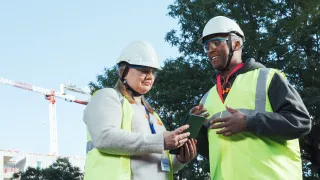Finnish Institute of Occupational Health media release 22 May 2025
A follow-up study by the Finnish Institute of Occupational Health examined the effects that remote and in-person work had on the well-being of experts at work in 2019—2023. According to the study, hybrid work functions well overall and is already very established.
"Some of today’s expert work is done remotely, some in person, and this matter must be managed. There are already many tools for supporting leadership, promoting a sense of community, and developing workspaces. They must continue to be used actively," says Annina Ropponen, Research Professor from the Finnish Institute of Occupational Health.
“In this research project, we investigated well-being at work at a weekly level and utilized extensive register data from five different employers,” she explains.
People stuck in remote work must be identified and supported
Hybrid work is not a threat to working life or well-being at work. However, the results demonstrate that there are individuals who are stuck in remote work, who are not independently active, and who the work community may forget about. This group of employees should be a concern.
"We must identify these people lost in remote work. We must provide them with support and a means of getting in touch with the work community. There can be a risk that they may either develop or already have challenges in performing or coping with work, various symptoms, or even difficulties with life management. If the situation continues, it can lead to sickness absences, which are costly for the workplace," says Annina Ropponen.
The research group recommends that employees who have opted to work entirely remotely for reasons for which they need support should be identified as part of supervisory work. These employees may also have an increased risk of mental health strain or symptoms. Supervisors must ensure that they are in regular contact with all their employees and also meet employees in person. Supervisory work can make use of general management tools that encourage employees to engage and participate in the work community.
Remote work is not reflected in sickness absences
According to the study, the number of remote working days was not related to short sickness absences (that is, 1-5 days by own notice). This suggests that it is not necessary to recommend a specific number of days of remote work, at least to reduce sickness absences.
"The result is encouraging. The coronavirus pandemic taught us that you should not go to work if you have symptoms or are ill. This could turn out to be a significant lesson to have learnt concerning future epidemic situations. However, in expert work, everyone must be able to assess whether they can work. Even in remote work, people have the right to be off when sick. In other words, remote work must not be used for people to work while sick," says Annina Ropponen.
The research group recommends that workplaces pay attention to guidelines and work culture to ensure that employees have the right to be ill and recover, also in remote work.
Attention to working conditions
It is important that workplaces continue to pay attention to working conditions in both remote work and at their premises. Business premises should invest in space solutions that provide a peaceful work environment to promote concentration and productivity.
The research group recommends that, when developing premises, workplaces take a multifaceted approach in assessing the significance of in-person work within the organisation and the workspaces it requires. The assessment must also take into account employees with different profiles of remote and in-person work. When consolidating workspaces, it is important to anticipate the need for quiet workspaces for activities such as remote meetings to avoid disturbances.
Read more about the study
- A follow-up study by the Finnish Institute of Occupational Health examined the effects that remote and in-person work had on the well-being at work of experts in 2019–2023.
- The study was based on extensive data, consisting of register data from five different employers and surveys carried out at different times.
- Learn more about the follow-up study (in Finnish): Well-being at work in remote and in-office work before, during and after the coronavirus pandemic (Julkari.fi)
- Presentation of the research project: Change in work after the coronavirus pandemic – research project on remote work and work at the offices among Finnish knowledge employees | Finnish Institute of Occupational Health
Further information
- Annina Ropponen, Research Professor, Finnish Institute of Occupational Health, annina.ropponen [at] ttl.fi (annina[dot]ropponen[at]ttl[dot]fi), tel. +358 (0)30 474 2012
- Annu Haapakangas, Chief Researcher, Finnish Institute of Occupational Health, annu.haapakangas [at] ttl.fi (annu[dot]haapakangas[at]ttl[dot]fi), tel. +358 (0)30 474 7521




